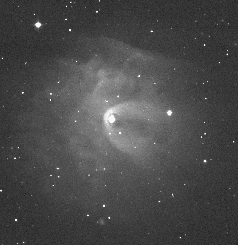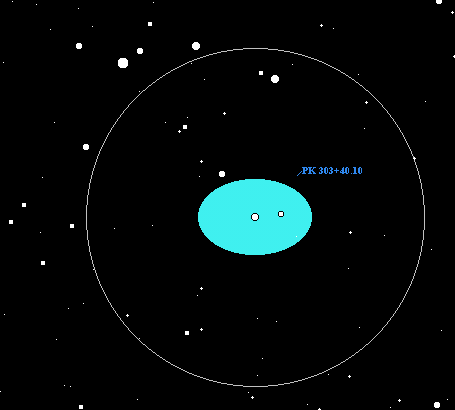
The other star in this system is a white dwarf. Hubble Space Telescope observations indicate that the white dwarf star is between 0.08" and 0.14" distant, corresponding to an actual separation of about 18AU, or 18 times the distance between the earth and sun. Hipparcos observations indicate that this system is about 400 light years away.
It is the white dwarf that produced the surrounding planetary nebula as it shed its outer layers thousands of years ago. Today, the UV radiation of the white dwarf ionizes the expanding shell of material causing it to glow.

This image shows the bow shock to the west of the bright central star. The image was taken at Kitt Peak National Observatory by George Jacoby and is ~12' x 12'.You will probably need at least a 12" scope to glimpse the brighter portions of this very low surface brightness nebula. An OIII filter may be necessary to bring it out in all but the largest apertures. I was unable to find any record of visual observation of the bow shock, although it might be visible in very large scopes. If anyone manages to see this feature, I'd sure like to know about it!
I've been intrigued with this one for years, ever since I saw the image with the curious "bow shock" feature. I wondered at the time if this feature was visible in my 6-inch under a dark sky. It turned out that I wasn't able to detect the nebula at all, much less the bow shock, but it was fun trying. In 2000 I had a try at it with my 18-inch f/4.5, but again I detected nothing. What brought me back in the 2001 observing season were my OIII and H-Beta filters.
In my 18-inch the nebula became apparent to me for this first time at 97x with the OIII in place. There are two bright stars in the area and the nebulosity appeared to surround both of them. It is very diffuse and irregular, and difficult to get a handle on any sort of shape. The H-Beta filter also revealed a little nebulosity, but not nearly as well as the OIII. Unfortunately I still could not make out the bow shock, although I thought I saw something arc-like at 135x with the H-Beta in place, so who knows, it may yet be possible.

The view in an LX-200 at 76x. North is down, East is right. The two stars within the nebula symbol are the same two bright stars seen in the photograph above.
| Abell 35 | R.A. | Dec. | Con | Mag | Mean Surface Brightness |
| aka PNG 303.6+40.0, PK 303+40.1 | 12h53m34.2 | -22o52'17" | Hydra | 12+? | 26.2 mag/arc-sec2 |
Millennium Star Atlas Vol II Chart 868
Sky Atlas 2000 Chart 21 Uranometria 2000 Vol II Chart 329 Herald-Bobroff Astroatlas B-06 C-57| Resources
used to make this page
Deep Sky Observing Guides |